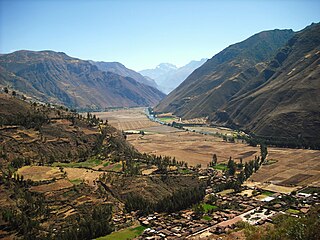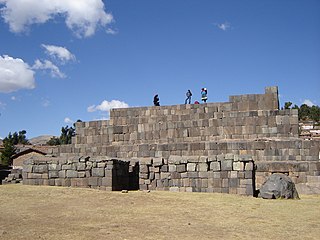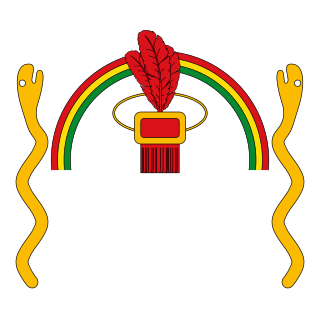Related Research Articles

Cusco or Cuzco is a city in southeastern Peru near the Urubamba Valley of the Andes mountain range. It is the capital of the Cusco Region and of the Cusco Province. The city is the seventh most populous in Peru; in 2017, it had a population of 428,450. Its elevation is around 3,400 m (11,200 ft).
Pachacámac is an archaeological site 40 kilometres (25 mi) southeast of Lima, Peru in the Valley of the Lurín River. The site was first settled around A.D. 200 and was named after the "Earth Maker" creator god Pacha Kamaq. The site flourished for about 1,300 years until the Spanish invaded. Pachacamac covers about 600 hectares of land.

The Wari were a Middle Horizon civilization that flourished in the south-central Andes and coastal area of modern-day Peru, from about 500 to 1000 AD.

Sacsayhuamán, often spelled Saqsaywaman or Xacxaguaman,, is a citadel on the northern outskirts of the city of Cusco, Peru, the historic capital of the Inca Empire. The site is at an altitude of 3,701 m (12,142 ft).

The Inca religion was a group of beliefs and rites that were related to a mythological system evolving from pre-Inca times to Inca Empire. Faith in the Tawantinsuyu was manifested in every aspect of his life, work, festivities, ceremonies, etc. They were polytheists and there were local, regional and pan-regional divinities.
This is a chart of cultural periods of Peru and the Andean Region developed by John Rowe and Edward Lanning and used by some archaeologists studying the area. An alternative dating system was developed by Luis Lumbreras and provides different dates for some archaeological finds.

The Sacred Valley of the Incas, or the Urubamba Valley, is a valley in the Andes of Peru, north of the Inca capital of Cusco. It is located in the present-day Peruvian region of Cusco. In colonial documents it was referred to as the "Valley of Yucay." The Sacred Valley was incorporated slowly into the incipient Inca Empire during the period from 1000 to 1400.

Inca architecture is the most significant pre-Columbian architecture in South America. The Incas inherited an architectural legacy from Tiwanaku, founded in the 2nd century B.C.E. in present-day Bolivia. A core characteristic of the architectural style was to use the topography and existing materials of the land as part of the design. The capital of the Inca empire, Cuzco, still contains many fine examples of Inca architecture, although many walls of Inca masonry have been incorporated into Spanish Colonial structures. The famous royal estate of Machu Picchu is a surviving example of Inca architecture. Other significant sites include Sacsayhuamán and Ollantaytambo. The Incas also developed an extensive road system spanning most of the western length of the continent and placed their distinctive architecture along the way, thereby visually asserting their imperial rule along the frontier.

Peruvian architecture is the architecture carried out during any time in what is now Peru, and by Peruvian architects worldwide. Its diversity and long history spans from ancient Peru, the Inca Empire, Colonial Peru to the present day.

Raqch'i (Quechua) is an Inca archaeological site in Peru located in the Cusco Region, Canchis Province, San Pedro District, near the populated place Raqch'i. It is 3480 meters above sea level and 110 kilometers from the city of Cuzco. It also known as the Temple of Wiracocha, one of its constituents. Both lie along the Vilcanota River. The site has experienced a recent increase in tourism in recent years, with 83,334 visitors to the site in 2006, up from 8,183 in 2000 and 452 in 1996.

In the Inca Empire the ushnu was an altar for cults to the deities, a throne for the Sapa Inca (emperor), an elevated place for judgment and a reviewing stand of military command. In several cases the ushnu may have been used as a solar observatory. Ushnus mark the center of plazas of the Inca administrative centers all along the highland path of the Inca road system.

Sayhuite (Sigh-weetey) is an archaeological site 47 kilometres (29 mi) east of the city Abancay, about 3 hours away from the city of Cusco, in the province Abancay in the region Apurímac in Peru. The site is regarded as a center of religious worship for Inca people, focusing on water. In the Monuments of the Inca by John Hemming, Hemming points to a colonial narrative that describes the interior of the Sayhuite temple. The temple featured larger columns draped in fabrics with gold bands the "thickness of one's hand." The temple was also under the care of the priestess Asarpay, who jumped to her death in the nearby 400 meter gorge to avoid capture by Spanish forces.

The Andean civilizations were South American complex societies of many indigenous people. They stretched down the spine of the Andes for 4,000 km (2,500 mi) from southern Colombia, to Ecuador and Peru, including the deserts of coastal Peru, to north Chile and northwest Argentina. Archaeologists believe that Andean civilizations first developed on the narrow coastal plain of the Pacific Ocean. The Caral or Norte Chico civilization of coastal Peru is the oldest known civilization in the Americas, dating back to 3500 BCE. Andean civilization is one of the six "pristine" civilizations of the world, created independently and without influence by other civilizations.
Philip Ainsworth Means was an American anthropologist, historian, and author. He was best known for his study of South America, specifically of the Inca Empire. Means made five extended trips to Peru where he studied the Incas of the Cuzco area and supervised excavations. He was the director of the National Museum of Archeology in Lima, Peru, and was associated with the Smithsonian Institution and the Peabody Museum of Archaeology and Ethnology. Means published many books, including Ancient Civilization of the Andes (1931), which became the standard textbook on Incan history and culture.

The history of human habitation in the Andean region of South America stretches from circa 15,000 BCE to the present day. Stretching for 7,000 km (4,300 mi) long, the region encompasses mountainous, tropical and desert environments. This colonisation and habitation of the region has been affected by its unique geography and climate, leading to the development of unique cultural and socn.

Muyuq Marka, also Muyuqmarka, is an archaeological site in Peru. It is the base of what was a round Incan tower, which is situated within the fortress Saksaywaman above Cuzco. It was used as a Temple of Inti, but became part of a complex of rectangular buildings which mostly still remain today. However, the temple and the two flanking towers were dismantled during the Spanish rule. What remains of Muyuq Marka indicates that it was "a round building with an open central court which had a fountain." The temple had triple walls, which were aligned with the zenith sunrise and the antizenith sunset.

The Neo-Inca State, also known as the Neo-Inca state of Vilcabamba, was the Inca state established in 1537 at Vilcabamba by Manco Inca Yupanqui. It is considered a rump state of the Inca Empire (1438–1533), which collapsed after the Spanish conquest in the mid-1530s. The Neo-Inca State lasted until 1572, when the last Inca stronghold was conquered, and the last ruler, Túpac Amaru, was captured and executed, thus ending the political authority of the Inca state.
Richard Lewis Burger, Ph.D., is an archaeologist and anthropologist from the United States. He is currently a professor at Yale University and holds the positions of Charles J. MacCurdy Professor in the Anthropology Department, Chair of the Council on Archaeological Studies, and Curator in the Division of Anthropology at the Peabody Museum of Natural History. He has carried out archaeological excavations in the Peruvian Andes since 1975, publishing several books and many articles on Chavin culture, a pre-Hispanic civilization that developed in the northern Andean highlands of Peru from 1000 BC to 400 BC. Burger is married to Lucy Salazar, a Peruvian archaeologist and long time collaborator on many research projects. His former doctoral student Sabine Hyland has become well-known as an Andean anthropologist.

A kancha is an Inca rectangular or trapezoidal walled enclosure composed of single-room buildings that face onto a common open courtyard or inner patio in the middle of the enclosure. Kanchas are widespread in the Inca Empire and normally have only one entrance gate. An Inca kancha includes constructions intended for a single function: housing, temples, palaces. In Cusco, the capital of the Empire there existed many kanchas, among them the Coricancha, the Sun temple, the Hatunkancha that housed aqllawasi the house of the acclas and Amarukancha, the large hall facing the main square called Huakaypata. Other notable kanchas are found in Ollantaytambo and Patallaqta.
References
- ↑ "Pre-Inca temple uncovered in Peru - CNN.com". Archived from the original on 2008-11-05. Retrieved 2008-03-16.
- ↑ Ancient temple unearthed near Inca capital, NBC News, March 14, 2008.
- ↑ NEWS - Comcast.net [ dead link ]
- ↑ Rowe, John Howland, "An Introduction to the Archaeology of Cusco,Papers of the Peabody Museum of American Archaeology and Ethnology, Harvard University 27 (2); Rowe, John Howland "Inca Culture,"B.A.E. 21:200
- ↑ See:
- Rowe, John H. (1944). "An introduction to the archaeology of Cuzco". Papers of the Peabody Museum of American Archaeology and Ethnology. 27 (2): i–xii, 1–69.
- Bauer, Brian S. (2004). Ancient Cuzco: Heartland of the Inca. Austin, Texas, USA: University of Texas Press. p. 74. ISBN 9780292792029.